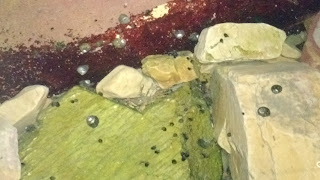Friday, July 28, 2017
The air
on site was warm, a steady breeze wafting off the ocean, up the cliff and
mixing with the chilly cave atmosphere. The gunners, clad in t-shirts, were on
the edge of the rising heat, while the excavators, a meter north, were in the
wash of both breeze and chill. Outside the cave, the heat was reminiscent of
summer, the sun’s
glare reflecting off rock and wave, the usually slick rocks dry, except those
still in the tidal zone.
 In the
cave, the excavators worked in now dry sediments, the colors suddenly shifted,
the soil easy to move. At second tea, when the heat had reached its zenith, the
excavation ceased. Artifacts are plotted, grids are closed, last minute closing
shots taken in as we scramble to clean up.
In the
cave, the excavators worked in now dry sediments, the colors suddenly shifted,
the soil easy to move. At second tea, when the heat had reached its zenith, the
excavation ceased. Artifacts are plotted, grids are closed, last minute closing
shots taken in as we scramble to clean up.
Once the
excavation tools were removed, we began pinning chits into the stratigraphy.
The chits, grey and white with crosshair and numbered, provide orientation for
the photographer after the fact, so that he or she can stitch the photographs
together. The chits are shot in with the guns, and this data integrated with
the photos, creating a 3D image with highly detailed sequence.
The quads
are given different chits, to mark the four corners NW NE SW SE. when all the
chits are placed, we begin shooting the guns. This task only requires three
people. The rest of us relax, hanging out on the edge of the cliff or packing
the remaining items.
The
second they are done, we grab the equipment, tripod and gun, throwing frame
packs over shoulders. Dr C and two others remained there to continue setting up
for the photography.
At the
vehicle, we quickly unpack, sending frame packs back for later use. Most of us
pile into the trucks, either finished for the night or dropping off those who
are finished. The sun is golden over the lagoon, quickly fading from sight as
we traverse town. In what is likely the project’s quickest dropoff, we shoo passengers from the car and
screech back onto the road.
 Daylight
is fading as we reach the glen. With hardly a pause, we throw ourselves from
the vehicle and hit the trail. The sun is fading quickly now; red and yellow
ghosts of the final rays hovering over the watery expanse. A handful of stars begin
to flicker, the moon gilding the uneven trails in a sheen of light. Below the
cave, in the tidal pools, sea creatures creep forth, scuttling across the rocks
at the first hint of a flashlight.
Daylight
is fading as we reach the glen. With hardly a pause, we throw ourselves from
the vehicle and hit the trail. The sun is fading quickly now; red and yellow
ghosts of the final rays hovering over the watery expanse. A handful of stars begin
to flicker, the moon gilding the uneven trails in a sheen of light. Below the
cave, in the tidal pools, sea creatures creep forth, scuttling across the rocks
at the first hint of a flashlight.
Inside, preparations
nearing completion. The handful of remaining crew is huddled over the chitted trenches.
Everyone is holding or wearing a luminated devise. When lit, the cut walls of
the excavation display the stark layers. And that is why we are onsite in the
dark, in the cold: to capture the color of the dirt without the interference of
the shifting natural light.
The camera
must be positioned exactly the same distance from the wall, every time. One person
holds the measuring tape: it is their job to scramble up and down the steep
sides of the trench, careful not to knock sediment or themselves into the trench
as they support the flimsy tape. Another person clutches a notebook, carefully
recording the position of every shot. This will be invaluable later, when
fitting the photos together or comparing them to a section. When the camera is
in position we click the flashlights out, or clasp hands over the headlamps, leaving
the site in darkness before the camera bulb explodes with a blinding flash. Occasionally,
someone forgets, leaving the light on and ruining the shot. We work quickly,
trading out jobs.
If there
is a moment’s break, we lie on the
sandbags, craning our necks over the outer staircase, staring at the sky. A myriad
of stars cover the darkness, spread across the sky like sand, abruptly
vanishing into the immovable outline or the cave. With the city light hidden
behind the ridged Knysna heads, it feels like we have been transported back the
Pleistocene, watching a watery landscape from the shelter of rock.
Eventually,
all the photos have been taken. Quickly the bags are packed, hungry
archaeologists eager to return to dinner. On the way out, our lights cast giant
shadows on the opposite rock wall. Once the ropes are stowed, we scramble silently,
hurriedly, towards the cars, ears alert for any noise. The glen is scarcely a
safe place in the light, it is decidedly less so after the sun has set. Once we
reach the glen, we run, throwing ourselves into the car and locking the doors. It
is colder now, and we are ready for food and shelter.
Below the
heads, electric lights encircle the Knysna lagoon, rising to meet the stars.










